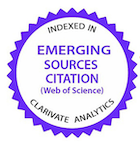ORIGIN AND ANTIMERIC DISTRIBUTION OF THE FEMORAL NERVES IN NEWBORNS GOATS OF THE SAANEN BREED
DOI:
https://doi.org/10.1590/1089-6891v16i225290Keywords:
Animal MorphologyAbstract
The femoral nerves were studied in newborn goats of Saanen breed (22 males and 11 females) that were collected after natural death and fixed with 10% formaldehyde solution. In males the femoral nerve arose from the ventral spinal branches of L4 and L5 in eight animals (36%); in six animals (27%) it arose from the ventral spinal branches of L5 and L6; in five animals (23%) it arose from the ventral spinal branches of L5; in two animals (9%) it arose from the ventral spinal branches of L4, L5 and L6 and in one animal (5%) it arose from the ventral spinal branches of L5 and L6 and the ventral spinal branches of S1. In females the femoral nerve arose from the ventral spinal branches of L4 and L5 in seven animals (64%); in three animals (27%) it arose from the ventral spinal branches of L5 and L6 and in one animal (9%) it arose from the ventral spinal branches of L4, L5 and L6. In all animals, the femoral nerves were distributed in different branches to the major and minor psoas, femoris quadriceps, sartorius and pectinius muscles.
Keywords: femoral nerve; Saanen; variation.
Downloads
Published
How to Cite
Issue
Section
License
Copyright (c) 2015 Brazilian Animal Science/ Ciência Animal Brasileira

This work is licensed under a Creative Commons Attribution 4.0 International License.
Authors who publish with this journal agree to the following terms:
- Authors retain copyright and grant the journal right of first publication with the work simultaneously licensed under a Creative Commons Attribution License that allows others to share the work with an acknowledgement of the work's authorship and initial publication in this journal.
- Authors are able to enter into separate, additional contractual arrangements for the non-exclusive distribution of the journal's published version of the work (e.g., post it to an institutional repository or publish it in a book), with an acknowledgement of its initial publication in this journal.
- Authors are permitted and encouraged to post their work online (e.g. in institutional repositories or on their website) prior to and during the submission process, as it can lead to productive exchanges, as well as earlier and greater citation of published work (See The Effect of Open Access).































